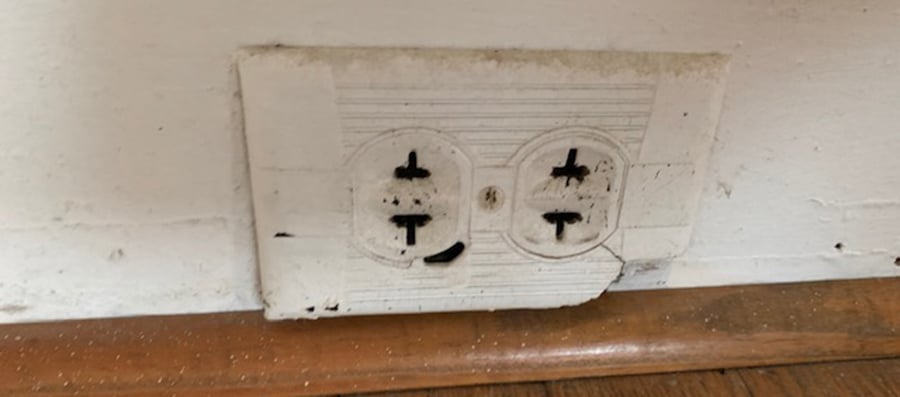
Ungrounded outlets are considered unsafe due to the risks they pose to people and property. The primary concerns associated with ungrounded outlets include:
- Electrical Fire: Without a ground present, issues with the outlet may lead to arcing, sparks, and an electrical charge that can ignite fires along walls or on nearby furniture and fixtures.
- Health Hazard: Ungrounded outlets increase the risk of electric shock to individuals using electronics and appliances plugged into them. This is because, in the event of an overload or fault, the excess electricity seeks the shortest path to the ground, which could be through a person.
- Property Loss: Ungrounded outlets can cause electrical equipment and appliances to short out, potentially rendering them useless. This is particularly concerning for expensive or essential household items.
- Indication of Other Electrical Issues: Ungrounded outlets, especially in older homes, may indicate piecemeal or outdated electrical work, suggesting a broader risk of electrical problems. These electrical defects make ungrounded outlets susceptible to arcing and electrical shorts that can cause nearby furniture or curtains to catch fire.
Grounded outlets became a standard in electrical codes to prevent these issues, offering a safer path for electricity to travel in the event of a fault. Grounding helps to protect against electrical fires, equipment damage, and personal injury by directing excess electricity safely into the ground.
Given these risks, upgrading ungrounded outlets to grounded ones, especially in homes where they coexist, is advisable to ensure electrical safety and compliance with current codes. This upgrade is particularly important for homeowners for insurance reasons and to protect occupants.
Get FREE estimates from licensed electricians in your area today. Whether you need to replace an outlet, hang a ceiling fan, a new electrical panel, or repair wiring, We Can Help!
According to Restoration Master Finder, a leader in the home restoration industry, ungrounded outlets top the list of causes of electrical house fires.
Other sources and electricians, such as Inspectapedia, KolbElectric, and Parker Young Construction, to name a few, concur that ungrounded outlets are not safe and that grounded outlets are safer.
The dangers of ungrounded outlets are echoed in this article, where Molly Hall, Director of Safe Electricity, discussed the dangers of ungrounded outlets and circuits. Safe Electricity is a public awareness program of the Energy Education Council. Let’s dive into what ungrounded outlets are and why they are dangerous.
Ungrounded outlets have several hazards, but there are ways to keep you and your family safe from house fires, electric shocks, etc. Read on and know-how!
What’s Wrong With Ungrounded Outlets?
In summary, ungrounded outlets lack the ground wire necessary to provide the same level of safety from house fires and electrical shocks offered by grounded outlets.
Ungrounded outlets are commonly 2-prong outlets, indicating that the home’s wiring is ungrounded. Ungrounded wiring can date back to when knob-and-tube wiring was prevalent. Ungrounded wiring has a “hot wire” and a “neutral wire,” but no copper ground wire is present. In contrast, modern residential wiring has a hot, neutral, and ground wire.
Ungrounded wiring was standard in pre-1970s homes. When overloaded, the electrical current travels through any conductor to ground itself to the earth, damaging electronic devices plugged into the circuit or causing electrocution when in contact with people.
As homes age, the protective sheathing on the electrical wiring starts to break down, which can cause electrical shorts or arcing to occur, resulting in a fire or electrical shock hazard.
Can You Ground an Ungrounded Outlet?
The only way to safely ground an ungrounded receptacle is to rewire the circuit with an electrical wire with a bare copper wire for grounding.
In summary, the NEC Section 406.4(D) states that a grounding path, such as the grounding prong on a three-prong receptacle (3-prong), should be grounded. However, two-prong outlets (2-prong) did not have this requirement because the grounding path did not exist. Short cuts to avoid rewiring a circuit is dangerous and unnecessary. You can use two NEC-approved methods to safely install 3-prong outlets on ungrounded wiring. We will discuss in a moment.
The problem arises when DIYers and amateur electricians remove two-prong outlets and replace them with three-prong outlets without replacing the electrical wiring or following NEC guidelines. Changing ungrounded outlets to grounded outlets is highly recommended because they prevent electrical hazards. However, the only recognized way to ground an ungrounded outlet is by rewiring the circuit— which can be costly.
In fact, according to HomeGuide.com, the cost to rewire a house averages about $7 per linear foot of wall space plus $1200 to $2500 for an electrical panel upgrade. See the chart below:
| Size House | Cost |
|---|---|
| Small House | $1500 – $3000 |
| Medium House | $3500 – $8000 |
| Large House | $8000 – $20,000 |
A grounded wire is essential because it provides a straight path for that current to return to the main breaker panel.
House fires are the most common hazard connected to ungrounded outlets. With the ground absent, hazards like arcing inside the outlet will result in electrical sparks, resulting in a fire. Electronics like computers and household appliances can also short circuit or cause an electrical shock when plugged into an ungrounded outlet. Electrical shorts with ungrounded circuits can cause severe injury or even death.
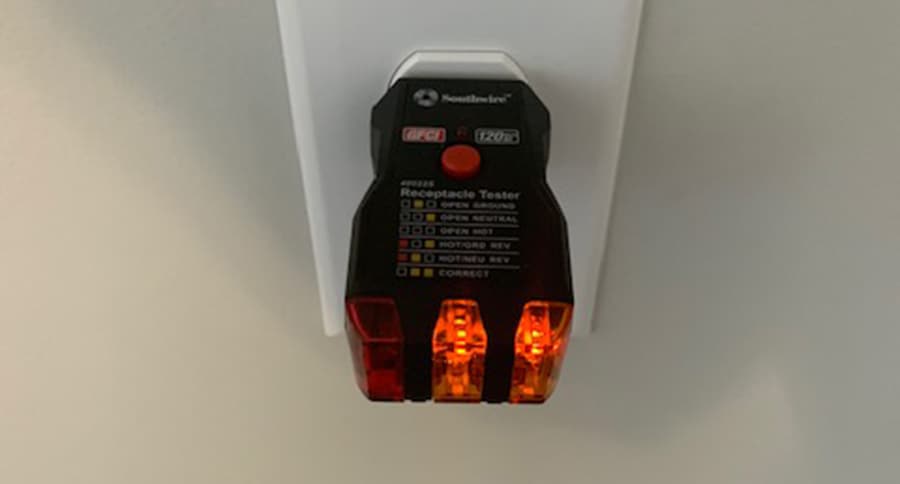
Does Code require Grounded Outlets?
Since 1962, the National Electric Code has required grounded outlets. Electrical code compliance for grounded outlets is necessary to build a house or renovations where drywall or plaster are removed.
Homes built with 2-prong outlets are “grandfathered,” and an update is not required to be code-compliant. Even today, 2-prong outlets are legal and code-compliant inside existing homes. However, according to the NEC, some requirements exist when replacing 2-prong outlets with 3-prong outlets.
Code compliance refers to building codes and permits. All new homes built require a building permit. Cosmetic improvements to an existing home do not require building permits.
Building permits on existing homes are required when:
- An addition is being built onto an existing home. Only the addition is subject to code compliance. The existing areas do not require upgrades to meet building codes.
- Renovations to the electrical system of an existing home require only the portion being renovated to meet the code requirements. For example, an exterior service mast and meter damaged in a storm only need the service mast and meter to meet current codes when repairs are made, not the entire house.
- Renovations that require wall coverings like plaster, paneling, or drywall to be removed require electrical upgrades in the areas being worked on only while the wall is open and accessible.
Don’t just assume that 3-prong outlets are grounded when buying an older home. We often see homes undergo retrofitting where a 2-prong outlet is replaced with a 3-prong outlet without rewiring the circuit or providing ground fault circuit interrupter (GFCI) protection.
So, this grounding aims to protect you from electric shocks while protecting your appliances and electronics from power surges that can damage them. However, many homes built before the 1970s still have ungrounded two-prong outlets.
Do all electrical outlets need to be grounded?
In an existing pre-1970s home, all electrical outlets need not be grounded. While having grounded outlets is recommended, it is not required.
If your home has existing 2-prong outlets, you can replace the outlet with a 2-prong outlet. However, replacing a 2-prong outlet with a 3-prong outlet requires GFCI protection at the outlet or the breaker.
The 2017 Code Language states:
406.4(D)(2) Non–Grounding-Type Receptacles. Where attachment to an equipment grounding conductor does not exist in the receptacle enclosure, the installation shall comply with (D)(2)(a), (D)(2)(b), or (D)(2)(c).
(a) A non–grounding-type receptacle(s) shall be permitted to be replaced with another non–grounding-type receptacle(s).
(b) A non–grounding-type receptacle(s) shall be permitted to be replaced with a ground-fault circuit interrupter-type of receptacle(s). These receptacles or their cover plates shall be marked “No Equipment Ground.” An equipment grounding conductor shall not be connected from the ground-fault circuit-interrupter-type receptacle to any outlet supplied from the ground-fault circuit-interrupter receptacle.
(c) A non–grounding-type receptacle(s) shall be permitted to be replaced with a grounding-type receptacle(s) where supplied through a ground-fault circuit interrupter. Where grounding-type receptacles are supplied through the ground-fault circuit interrupter, grounding-type receptacles or their cover plates shall be marked “GFCI Protected” and “No Equipment Ground,” visible after installation. An equipment grounding conductor shall not be connected between the grounding-type receptacles.
Informational Note No. 1: Some equipment or appliance manufacturers require that the branch circuit to the equipment or appliance includes an equipment grounding conductor.
Informational Note No. 2: See 250.114 for a list of a cord-and-plug- connected equipment or appliances that require an equipment grounding conductor.
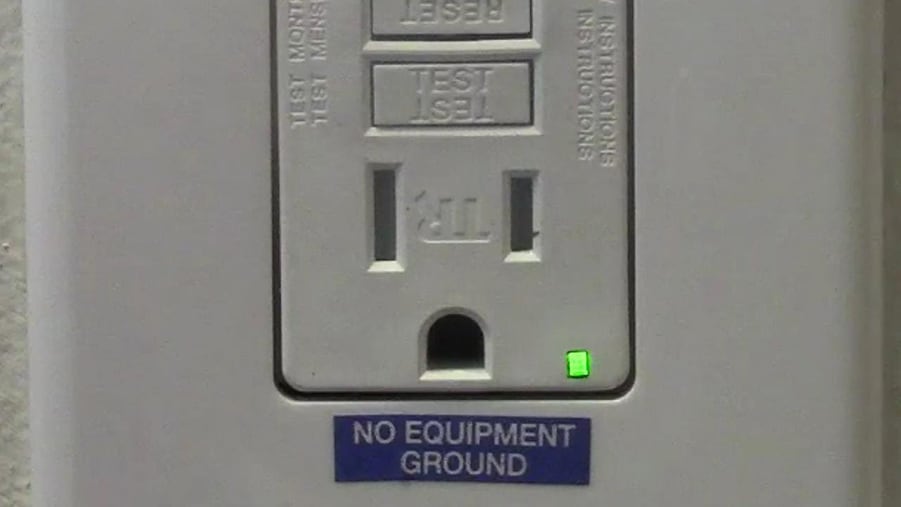
According to the National Electric Code, you are allowed to replace your existing 2-prong outlet if:
- You replace it with another 2-prong ungrounded outlet. No wiring upgrade is required under the building code.
- You can replace a 2-prong outlet with a 3-prong GFCI outlet, provided the new 3-prong outlet is labeled “No Equipment Ground.”
- You can replace a 2-prong outlet with a standard 3-prong outlet and install a GFCI breaker inside the panel box to protect the circuit. The new 3-prong outlet must still be labeled “No Equipment Ground.”
So, you aren’t breaking any electrical codes if you keep ungrounded outlets and do not replace the house wiring.
However, grounded outlets are a must for modern sensitive electronics, including appliances in your kitchen such as refrigerators, microwaves, grinders, etc., and devices such as computers, vacuum cleaners, and air conditioners because these appliances come with a three-prong outlet.
Plugging these devices into the surge protector with the help of an adapter might seem like the way to go, but it isn’t. Surge protectors don’t protect when no ground is present, and surge protectors don’t ground ungrounded outlets.
Older 2-prong outlets (and grounded outlets) still lack surge protection, and using an adapter makes no difference. Doing so will only create an appliance and electrocution hazard. So, it is essential to plug any three-pronged appliances into 3-pronged outlets to remain safe and secure.
According to the electric code, GFCI outlets are a MUST in certain areas of your home, such as:
- Outlets in laundry areas
- Outlets in bathrooms
- Outlets in the kitchen
- Outlets in unfinished basements or crawl spaces
- Outlets in outdoor areas and garages
- Outlets near water like swimming pools, fountains, etc
This is because most of these areas have some water source present, and the presence of water makes ungrounded outlets far more dangerous than they are. Rooms such as bathrooms, kitchens, laundry areas, etc., are wet areas.
Thus, if ungrounded outlets are present, operating them can be quite dangerous as they can easily lead to electric shocks and, in some extreme cases, fires.
However, GFCI protection is required in 2-prong to 3-prong outlet conversions because the GFCI sensors monitor the electrical flow across the positive and neutral prongs and can cut power to the circuit in the event of a ground fault in the circuit to prevent electrical fires and save lives.
How Do You Fix an Ungrounded Outlet?
You can fix ungrounded outlets by rewiring the electrical circuit or installing GFCI protection at the outlet or circuit breaker. Rewiring is the only option that will ground the outlet safely. GFCI protection will not ground the outlet but monitor the electrical current flowing through the circuit and cut power to the circuit when a ground fault occurs.
To do that, you can purchase an outlet tester and test every 3-prong outlet in the home. Outlet testers have lights on them that indicate how the outlet is wired. Most outlet keys will look like this:
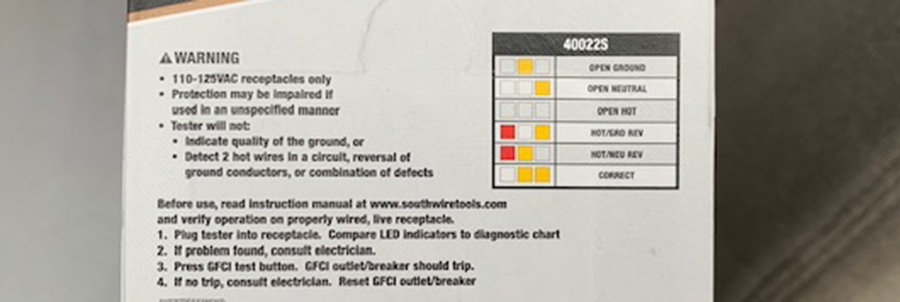
- If the center light only lights up, the outlet has an “Open Ground,” meaning it has no ground wire present or the ground wire is loose somewhere on the circuit.
- It the center and right sides both light up, and the outlet tester is detecting a ground wire is present.
This likely means the outlet is wired correctly, but outlet testers can not detect a false ground or “bootleg ground.”
A false ground can occur when:
- A small wire is looped from the neutral terminal to the grounding terminal, creating a false bootleg ground.
- Since older outlets have metal junction boxes, a small ground wire is run from the grounding terminal to the metal outlet box.
Neither of these methods is recognized under the National Electric Code and is considered misleading and dangerous. Many house flippers use these methods to trick buyers and home inspectors.
To check for bootleg grounding requires removing the faceplate from the outlet to examine the wiring itself or examining the wiring at the electrical service panel to locate the circuit and the grounding wire.
The only recognized method by the National Electric Code is the GFCI method we outlined above. So, let’s examine both GFCI methods.
How Much Does It Cost to Fix Ungrounded Outlets?
To replace a 2-prong outlet with a GFCI outlet is relatively straightforward. It merely requires replacing the old 2-prong outlet with a GFCI outlet. This method works great if you only have a few outlets to replace.
GFCI outlets cost about $20-$60 each (depending on the type), so replacing one or two isn’t too expensive. However, replacing a house full of 2-prong outlets can be costly using this method.
For a house full of 2-prong outlets, replace the 2-prong outlets with standard 3-prong outlets and replace the standard circuit breakers with GFCI breakers. The GFCI breakers will protect the entire circuit of outlets rather than only an individual outlet.
A GFCI breaker costs about $40-$60 each. A standard three-prong receptacle costs about $10 each. For example, replacing 30 2-prong outlets on six circuits will cost about $750-$1000 for material and labor costs. The cost will vary based on several factors, but this is much safer for your family and is cheaper than rewiring the entire house.
Is an Ungrounded GFCI Outlet Safe?
If the outlets within your home are ungrounded, replacing those outlets with a GFCI outlet can be a quick and easy fix for the problem. GFCI conversion is inexpensive, costing around $20-$60 each. You can easily purchase a GFCI outlet and replace your ungrounded, 2-prong outlets with it, and you will have a much safer outlet.
However, the question is whether ungrounded GFCI outlets are safe. The answer could be a little tricky to understand. Though this option can be like a simple fix for ungrounded wiring, we do not suggest installing this as a permanent fix. A GFCI’s main aim is to safeguard you from electrocution and not protect your appliances from power surges.
Therefore, whereas using a GFCI outlet with an ungrounded system protects you from any electrical shocks, your electrical devices can still be in danger because the GFCI outlets do not ground the circuit. It merely protects you from any potential electrocution hazards. So, to secure all your electronics, you may need to wire your outlets to be grounded and safer, preventing them from getting damaged.
Another reason why many of us stay skeptical regarding using GFCI outlets with an ungrounded electrical system could be a chance of the GFCI failing to work. Several studies over the years cited the failure rate for GFCI circuit breakers and outlets, and the studies found that in case of power surges or short circuits, it had been possible for the GFCIs to fail and stop working.
To combat this, GFCIs should be tested monthly. To test a GFCI, press the test button on the outlet or breaker. The outlet or breaker should trip, and you should easily reset the GFCI outlet or breaker.
Most newer GFCIs will trip when they fail and do not reset. Older GFCIs would fail but not trip to cut off the electrical current. In essence, a failed live GFCI defeated the purpose of having the GFCI in the first place, so manufacturers changed it.
In areas with many thunderstorms and lightning, it is also likely for GFCIs to fail. If a GFCI fails, there would be no protection on the outlets. The GFCI will not turn off the electrical current passing through the circuit, making the outlets unsafe and dangerous.
GFCIs can fail a home inspection but are very easy to fix.
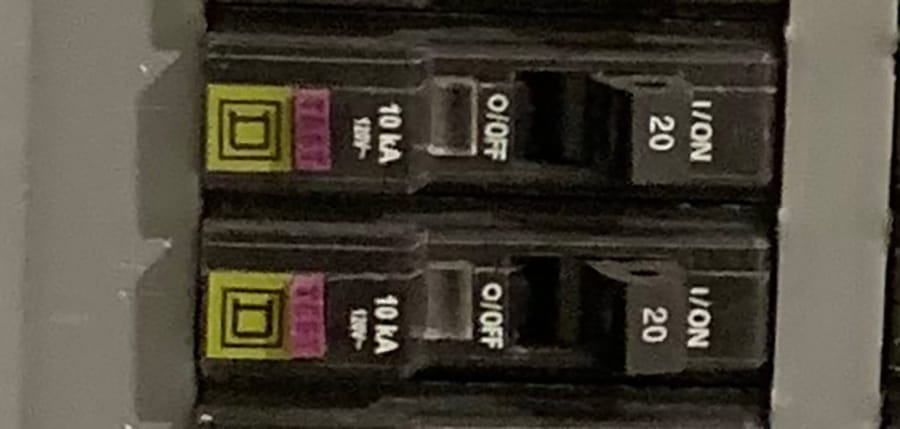
Will a GFCI Breaker Protect Ungrounded Outlets?
One of the main fixes for ungrounded outlet problems is rewiring the entire electrical system within your home. However, this can be costly and may take a lot of time, as it requires a professional to do the job. So, if rewiring your outlets is not possible or convenient for you, another simple way to fix an ungrounded circuit will be using a GFCI breaker.
A GFCI breaker will protect all the outlets on that individual circuit. When a ground fault occurs in the circuit, the breaker will trip to cut off power to the circuit. One potential drawback is that the GFCI will cut power to the entire circuit if one outlet fails.
A GFCI breaker is often a convenient and comparatively inexpensive method to fix an ungrounded outlet inside your home, as a GFCI breaker retails for about $40-$60. The best part regarding this method is that by using a GFCI breaker at the service panel, all the circuits and outlets in your home will be protected and safe to use.
While the GFCI breaker will protect the ungrounded outlets and make them safer, this method still has a high risk. Understanding that the breaker will not act the same way as the grounding works is essential. The GFCI breaker does not ‘ground’ the outlet; it merely protects you from the risks associated with ungrounded outlets.
The GFCI breaker senses the changes in the incoming and outgoing current. If it senses a sudden increase, which would happen if, for example, a human gets electrocuted, the breaker shuts off the current passing through the outlets. However, the breaker will not protect against voltage surges, as the GFCI is not designed for that purpose.
So, using a GFCI breaker to fix ungrounded outlets will only protect you from electric shocks. Still, it cannot protect your appliances and electronics from the risk of getting damaged beyond repair.
Are Ungrounded Outlets Safe? Now You Know
You can confidently say that ungrounded outlets are quite unsafe and will pose a significant threat to you, your family, and the appliances you own and use in your home. These outlets can not only harm you, but they can also damage all the electronics you use on a day-to-day basis, resulting in you needing to spend more money to replace these outlets and your electric devices.
We have mentioned all the possible hazards involved with ungrounded outlets, and now that you’re aware of the dangers that come with ungrounded outlets, you know how these outlets can turn out to be extremely dangerous, adding risk to the tasks you carry out daily.
Ungrounded outlets can cause not only damage to your appliances but also increase the risk of you or your loved ones getting electrocuted. In the worst-case scenarios, your house can catch fire, too. Hence, the risks attached to ungrounded outlets are not just limited to your appliances but also your health, life, home, and wallet.
So, it is necessary to understand your home’s outlets’ complexity and make the required adjustments to ensure your safety.
Get FREE estimates from licensed electricians in your area today. Whether you need to replace an outlet, hang a ceiling fan, a new electrical panel, or repair wiring, We Can Help!








